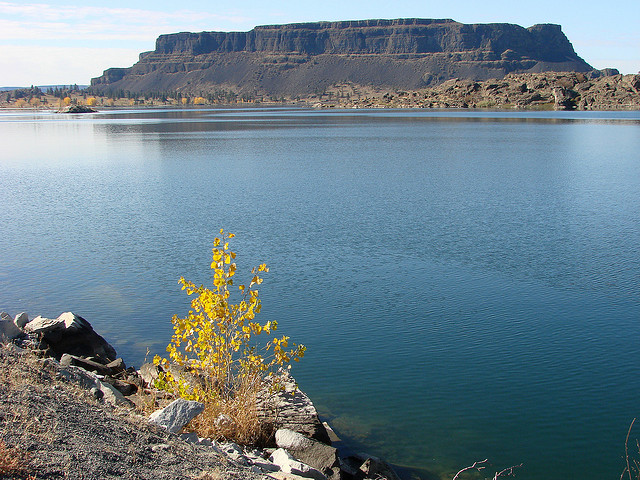
In the arid fastness of eastern Washingtons Columbia Basin travelers discover the welcome presence of water in the desert. How water got to this Coulee Country is an interesting geological story. First came ancient lava flows, which were later scoured into hundreds of canyons (or coulees) by repeated epic floods at the end of the last ice age. Much later, dams on the Columbia River and decades of irrigation filled some of the canyons with water, and created seep lakes and a spidery network of waterways.
You can paddle a canoe along these peaceful canals, or water-ski its lakes, or simply spread your picnic in a lake side campground. Fishing for bass and perch here can be very good. Try especially Banks, Sun, Park, Blue, and Lenore lakes. Northeast on the Columbia River is Lake Roosevelt National Recreation Area. Behind the dam is 150-mile long Lake Roosevelt, where you can rent a houseboat for independent cruising from outfitters like Lake Roosevelt Vacations, 509-738-6121. Park Service programs include guided canoe trips.
Southward, sprawling across I-90 about 65 miles east of Ellensburg, lies Moses Lake. The lake shore is dotted with parks and boat launchesbases for water-skiers, swimmers, bird-watchers, campers, canoeists, sail-boarders, and anglers pursuing trout, bass, crappie, blue-gill, perch. For visitor information, call 800- 992-6234. But Moses Lake is just the beginning of watery adventures here. A bit farther south lies Potholes Reservoirits numerous islands, reedy shorelines, and labyrinth of canals and waterways attract all sorts of boaters, fishermen, campers, and wildlife watchers. Potholes State Park is one base for visitors; Mar Don Resort is another.
Just a bit farther south flows Crab Creek, which links a series of seep lakes renowned among the states fisherman. These officially designated quality waters harbor huge rainbow trout, best pursued with classic fly-fishing tackle. Fishing season here is split between spring and fall (no fishing in summer).
Near Yakima, more exceptional water in the desert experiences await along the Yakima River, an hours drive southeast of Snoqualmie Pass via I-90 and I-82. Choose a leisurely float trip through the spectacular Yakima Canyon, or hire a guide and fly-fish for trophy-sized wild native rainbow trout. The Yakima is the states major catch-and-release trout stream; its open year-round.
Farther south, at the confluence of the Yakima and Columbia rivers, lies the Tri-Cites, (Kennewick, Pasco, Richland). The Columbia offers all sorts of recreationboating, swimming, and water-skiing and golfing by the riverside. For a touch of adventure, join a jet-boat tour with Columbia River Journeys to see ancient rock carvings (call 509-943-0231). Or, if times short, step out from certain river front motels to enjoy a stroll along the areas emerging river-walk trail system.